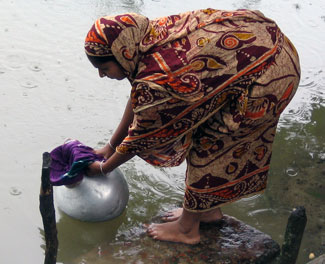Sari cloth can filter cholera from water, research shows
January / February 2015 | Volume 14, Issue 1

Photo courtesy of Dr. Anwar Huq/University of Maryland
A simple method of filtering water through sari cloth can
reduce cholera incidence by nearly half.
by Cathy Kristiansen
A simple method of using readily available sari cloth to filter pond and river water successfully reduced the incidence of cholera by nearly half in a study conducted in Bangladesh. Funded by the NIH's
National Institute of Nursing Research (NINR), the findings may have applications in other low-resource settings. More than 1 billion people worldwide lack access to safe drinking water and over 5 million die each year from waterborne illness, according to the WHO.
In many rural areas of Bangladesh, women use surface water for their household since it may be safer than well water, which can contain arsenic. The research team took its cue from a local practice to rid drinking water of insects and leaves by pouring it through sari cloth. Lab tests supported by the Thrasher Research Fund showed that a filter made of four layers of worn cotton material held back more than 99 percent of all cholera bacteria - using more layers or newer cloth slowed water collection too much.
"The filter is unique and useful," said Dr. Anwar Huq, who has collaborated on the project with University of Maryland colleague Dr. Rita Colwell. "It doesn't require any money or sophisticated training and the women bringing water to the house enthusiastically used the filtration, once the benefit was explained to them."
To test the filter's effectiveness, Huq and his colleagues studied about 45,000 residents, all in households with children under age five, who are typically more vulnerable to cholera. They showed the women how to use sari cloth to filter water that would be consumed or used to clean teeth, food and tableware. They followed up by visiting the village every two weeks to encourage compliance. An additional group of villages served as controls, adopting no interventions. In the households that were filtering water, cholera incidence was about half the level of the control participants and infections arising were milder, the scientists reported in
Proceedings of the National Academy of Sciences. The study also showed the practice benefited neighbors who did not filter their water, by reducing the overall incidence of cholera in the community.
In a follow-up study five years later, researchers discovered about one-third of participants continued to filter water as trained. Huq suggested repeated training and messages on TV and the radio could improve usage. He added he hopes to investigate if the filter blocks other waterborne pathogens as well, such as
E. coli.
More Information
To view Adobe PDF files,
download current, free accessible plug-ins from Adobe's website.